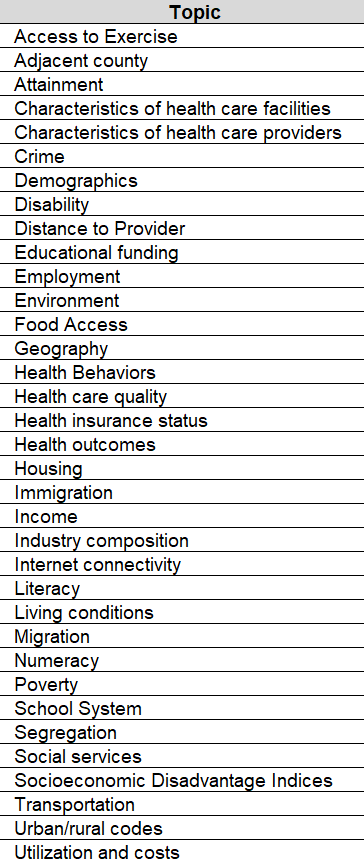HDG #025: AHRQ’s SDOH Database
Read time: 5 minutes
Greetings, SDOH Warriors (language I stole from Dr. Ellen Fink-Samnick)!
In this week's edition, we’re focusing on a resource that has been on my radar for a while, but recently started using for SDOH (Social Determinants of Health) analysis: The Agency for Healthcare Research & Quality (AHRQ)'s Social Determinants of Health Database.
And it’s pretty darn helpful. Let’s dive in!
What is the AHRQ's SDOH Database?
The AHRQ's SDOH Database is a data resource that provides healthcare professionals and researchers with a plethora of data on five crucial SDOH domains: social context, economic context, education, physical infrastructure, and healthcare context. The database collates this information from various sources and presents it at varying geographic resolutions, such as county, ZIP Code, and census tract levels.
Its aim is to offer a holistic view of the factors that influence health outcomes in different communities, enabling more informed decisions in healthcare delivery, research, and strategic planning. And AHRQ has already invested time into creating this “short-list” so that you don’t have to comb through the many, many, many Census indicators to create something similar.
Why Use It?
Time-saver: No more combing through multiple source files. This database integrates a wide breadth of pre-curated and vetted data, simplifying and speeding up the research process, even providing some rudimentary visualization tools. I also like that the data is very easily available for download in an Excel file. This makes it really accessible to citizen analysts.
Richness of Data: With variables spanning five key SDOH domains, from social context to healthcare context, and availability at county, ZIP Code, and census tract levels, the depth and breadth of data are unmatched.
A Trusted Source: Developed under the aegis of the Patient Centered Outcomes Research (PCOR) Trust Fund, it stands as a reliable repository for healthcare professionals and data analysts and is backed by the well-known work of AHRQ.
What's Inside?
Drawing from a plethora of sources, the database encapsulates:
Social Context: including age, race/ethnicity, veteran status, social cohesion, discrimination facets, and community safety, among others.
Economic Context: metrics around income, employment, and poverty.
Education: quality of education, literacy rates, and English proficiency.
Physical Infrastructure: housing, crime, transportation, and more.
Healthcare Context: data regarding health insurance, healthcare laws, and health promotion initiatives
The files also come with year-wise data files, codebooks, and a comprehensive documentation file.
The table below summarizes the number of indicators from different data sources for the county-level data. I like that there is a fair amount not from ACS/Census (at the county-level, anyway. Many of the sub-county level data is from ACS, which represents room for improvement in the future.
In all, you’ll find:
675 variables at a county-level
319 variables at the zip-level
321 variables at the tract-level
From 20+ different sources
(at least, at the county-level)
With data like:
And Visual Tools
AHRQ has also prepared a visualization tool demonstrating the possibilities of the SDOH data files. An example is the "Poverty and Access to Internet, by County" visualization, which overlays data on household tech access with poverty percentages, providing a clear picture of disparities.
Potential Uses
Holistic Patient Care: By understanding SDOH at the community level, healthcare systems can tailor their care and recommendations, resulting in more personalized and efficient patient care.
Community Engagement: By understanding specific SDOH challenges, health systems might be inspired to initiate community-level solutions. Think of setting up farmers' markets in areas identified as food deserts or creating safe exercise zones in areas with high obesity rates.
Research & Analysis: With such rich data at your fingertips, analysts can spearhead in-depth research projects, potentially unlocking findings that can lead to improved health outcomes.
Strategic Planning: For organizations looking to expand or reposition their services, the database can offer a treasure trove of insights, helping make informed decisions.
AHRQ also has a library of tools and resources for users that build upon this data, such as forming clinical-community linkages, tools and resources on care coordination, delivering culturally and linguistically competent care, delivering health literate care, and a tool to help primary care practices screen and refer patients for social needs such as food or housing, among other things you can find on their site.
. . .
Actionable Idea of the Week:
Download the data file and familiarize yourself with the database here.
Review the Data Source Documentation (PDF, 6 MB) for comprehensive insights on database structure and contents.
. . .
In an era where data drives (or, should drive) decision-making, the AHRQ's SDOH Database is an invaluable starter tool for healthcare professionals, and especially for data analysts. Whether you're in research, healthcare delivery, or strategic planning, this tool offers a granular view of the multifaceted dimensions affecting health outcomes.
While it doesn’t have all the data I’d like to see in a tool like this, it is one heck of a good start. And we will continue exploring datasets to support more robust SDOH analyses in future issues of Health Data Guru (HDG). Until then, stay informed and keep making an impact together.
See you next week!
-Stefany
Like my content? If you want to learn more about health data, population health, and health equity, I recommend subscribing to my newsletter and checking out my free Guides. Courses and more resources are coming soon, so check back often!




